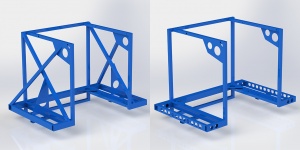Difference between revisions of "DEWBOT XI Internal Stacker"
MaiKangWei (talk | contribs) (→U-Chassis) |
MaiKangWei (talk | contribs) (→U-Chassis) |
||
| Line 13: | Line 13: | ||
==U-Chassis== | ==U-Chassis== | ||
| − | To minimize the stack's impact on robot center-of-mass, we decided to build the stack within the chassis. To score by simply dropping the stack and backing up to disengage, we determined to have no floor under the stack carried by the robot. These decisions led to a decision for a U-chassis, Sab-BOT-age's first. Form must follow function. | + | [[image:DB11_chassis_diet.jpg|300px|right|thumb|Chassis weldment - before and after "diet"]]To minimize the stack's impact on robot center-of-mass, we decided to build the stack within the chassis. To score by simply dropping the stack and backing up to disengage, we determined to have no floor under the stack carried by the robot. These decisions led to a decision for a U-chassis, Sab-BOT-age's first. Form must follow function. |
This was our scariest design decision. From 2009, we have designed rugged welded chassis frames. How to do this for a U-chassis? Is this even possible? | This was our scariest design decision. From 2009, we have designed rugged welded chassis frames. How to do this for a U-chassis? Is this even possible? | ||
Revision as of 17:58, 5 April 2015
Our main scoring system allows us to build stacks of up to six Totes under a Recycle Container and to score these. This stack is built inside the robot chassis and we score by simply dropping the stack and backing up. This required a U-chassis, the scariest design element of DEWBOT XI.
Stacking Strategies
Analysis of this game makes it clear that in competitive matches, RCs will constrain scoring potential and maximizing the score per RC is therefore essential. The only sensible stacking strategy is therefore to:
- Pick up an RC
- Build an stack of six totes under the RC
- At some point in the process, put litter in the RC
- Score the stack and repeat the process
The resulting stack scores 42 points per RC, the maximum possible. The robot should produce as many of these stacks as possible.
Human Player Station versus Landfill loading: Ideally, be able to do both. We focused on Human Player station loading due to the perception that it would be faster. The 30 human player totes provide materials for 5 stacks.
U-Chassis
To minimize the stack's impact on robot center-of-mass, we decided to build the stack within the chassis. To score by simply dropping the stack and backing up to disengage, we determined to have no floor under the stack carried by the robot. These decisions led to a decision for a U-chassis, Sab-BOT-age's first. Form must follow function.This was our scariest design decision. From 2009, we have designed rugged welded chassis frames. How to do this for a U-chassis? Is this even possible?
To help overcome the intrinsic weaknesses of a U-chassis, we designed the chassis around a sturdy "backbone": a 41.5" long 2" x 2" x 0.125" wall 6061 Al square tube. This backbone was not cut for light-weighting, except at the very terminal ends.
Structural connections across the robot's back at different heights were also included to provide structural integrity. 1" x 1" x 0.125" wall 6061 Al square tube members were employed for this purpose.
Extensive diagonal bracing and gusseting was originally designed and planned. The need to rationalize weight led to a significant reduction in this bracing (with some trepidation).
